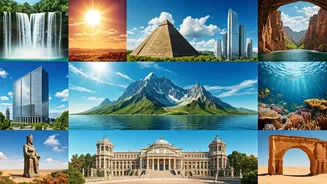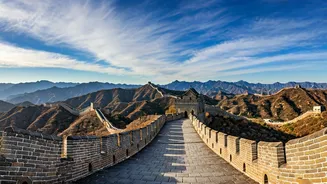Great Wall of China
The Great Wall of China is a symbol of China's rich history and architectural prowess. Stretching across thousands of miles, the wall was constructed over
centuries. Each section showcases unique construction techniques, adapted to the specific geographical conditions. Beyond its defensive purposes, the Great Wall also served as a transportation corridor and a communication network. It is a testament to human determination and innovation, a wonder that has captivated visitors for centuries. A visit offers an unparalleled experience, enabling one to walk along its ancient paths and marvel at the panoramic views.
Machu Picchu, Peru
High in the Andes Mountains of Peru lies Machu Picchu, an ancient Inca city that continues to fascinate. Built in the 15th century, its exact purpose remains a subject of debate. The city's sophisticated construction, blending seamlessly with the surrounding landscape, displays the Incas' mastery of architecture. Visiting Machu Picchu is an adventure, involving a trek through stunning landscapes, with breathtaking views. The site’s significance extends far beyond its physical beauty, offering insight into the sophisticated Inca civilization and the mysteries it holds.
Taj Mahal, India
The Taj Mahal, situated in Agra, India, is a monument to eternal love, commissioned by Mughal emperor Shah Jahan. Built in the 17th century, this mausoleum stands as a testament to the enduring power of love. The use of white marble, combined with intricate carvings and precious stones, makes it an architectural masterpiece. The Taj Mahal showcases Mughal architecture's elegance and artistic detail. It reflects a remarkable blend of cultures, serving as a reminder of the beauty created when artistry and affection converge. The building is known worldwide for its balance, symmetry and overall harmony.
Colosseum, Rome
The Colosseum, an iconic symbol of ancient Rome, offers a glimpse into the entertainment and engineering of the Roman Empire. Constructed in the 1st century AD, this amphitheater once hosted gladiatorial contests, public spectacles, and dramatic events. Its innovative design, including an elaborate system of arches and vaults, allowed it to accommodate thousands of spectators. Today, it remains an impressive feat of architecture. Walking through the Colosseum is a journey through history, an opportunity to imagine the events that once unfolded within its walls. The Colosseum stands as a testament to Roman power and ingenuity.
Petra, Jordan
Carved into sandstone cliffs in Jordan, Petra is an ancient city that captivates with its unique architecture and history. The Nabataean civilization established this city during the 4th century BC. Its stunning structures, including the Treasury and Monastery, show a mastery of rock-cut architecture. Petra's strategic location along trade routes made it a significant center of commerce. It also offers a view of the Nabataean’s ability to manipulate their environment. Exploring Petra involves traversing narrow canyons, which opens up to reveal the stunning rock-cut facades. A visit allows you to step back in time, and discover the mysteries of this once-thriving civilization.
Chichen Itza, Mexico
Chichen Itza in the Yucatan Peninsula of Mexico is a testament to the sophisticated Maya civilization. This ancient city thrived for centuries, with its structures reflecting advanced knowledge of astronomy, mathematics, and engineering. The centerpiece, the pyramid of El Castillo, is a remarkable example of Mayan architectural and astronomical precision. The site also includes various temples, observatories, and ball courts that showcase the Mayan culture. Walking through Chichen Itza is like stepping into a world of complex rituals and advanced understanding. Visiting this site is an immersion into the legacy of the Maya, and it showcases their enduring influence.
Christ the Redeemer, Brazil
Perched atop Corcovado Mountain in Rio de Janeiro, Brazil, Christ the Redeemer is a symbol of faith and a testament to Brazilian resilience. The statue, completed in the 1930s, offers unparalleled views of the city. This art deco statue has become a global icon, representing peace and hope. Its imposing presence overlooks the vibrant city. Reaching Christ the Redeemer involves a scenic journey, with a breathtaking reveal. The statue’s significance extends beyond its visual appeal. It serves as a spiritual landmark for millions, showcasing the strength of faith. A visit allows one to capture amazing moments and witness the beauty of Rio de Janeiro.
Eiffel Tower, Paris
The Eiffel Tower, a landmark in Paris, symbolizes engineering and artistic innovation. Constructed for the 1889 World's Fair, it was initially met with mixed reactions. Designed by Gustave Eiffel, the iron lattice structure has become a global icon of love and romance. Its construction represents the height of technological achievement. Ascending the Eiffel Tower offers stunning views of Paris, enabling visitors to soak in its urban landscape. The tower’s significance extends beyond its visual appeal, representing a city’s innovative spirit. Visiting the Eiffel Tower is a rite of passage for many, and it remains a highlight for visitors worldwide.
Angkor Wat, Cambodia
Angkor Wat in Cambodia represents a masterpiece of Khmer architecture. This massive stone temple complex was built in the 12th century, showcasing the cultural and religious importance of the Angkorian empire. Dedicated to the Hindu god Vishnu, Angkor Wat features intricate bas-reliefs and architectural details. The temple's impressive scale and precise design show a mastery of engineering. Exploring Angkor Wat involves walking through vast courtyards and viewing detailed carvings. A visit offers a look into a complex spiritual and artistic world. The site's significance extends beyond its visual appeal, representing the power and cultural wealth of the Khmer empire.











